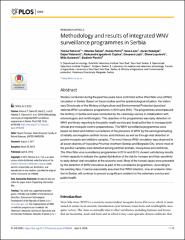| dc.contributor.author | Petrović, Tamaš | |
| dc.contributor.author | Šekler, Milanko | |
| dc.contributor.author | Petrić, Dušan | |
| dc.contributor.author | Lazić, Sava | |
| dc.contributor.author | Debeljak, Zoran | |
| dc.contributor.author | Vidanović, Dejan | |
| dc.contributor.author | Ignjatović Ćupina, Aleksandra | |
| dc.contributor.author | Lazić, Gospava | |
| dc.contributor.author | Lupulović, Diana | |
| dc.contributor.author | Kolarević, Mišo | |
| dc.contributor.author | Plavšić, Budimir | |
| dc.date.accessioned | 2019-11-04T11:56:09Z | |
| dc.date.available | 2019-11-04T11:56:09Z | |
| dc.date.issued | 2018 | |
| dc.identifier.citation | Petrović T, Sˇekler M, Petrić D, Lazić S, Debeljak Z, Vidanović D, et al. (2018) Methodology and results of integrated WNV surveillance programmes in Serbia. PLoS ONE 13(4): e0195439. https://doi.org/10.1371/journal. pone.0195439 | en_US |
| dc.identifier.issn | 1932-6203 | |
| dc.identifier.uri | https://repo.niv.ns.ac.rs/xmlui/handle/123456789/126 | |
| dc.description.abstract | Studies conducted during the past few years have confirmed active West Nile virus (WNV)
circulation in Serbia. Based on these studies and the epidemiological situation, the Veterinary
Directorate of the Ministry of Agriculture and Environmental Protection launched
national WNV surveillance programmes in 2014 and 2015. The programmes encompassed
the territory of Serbia and were conducted by the veterinary service in collaboration with
entomologists and ornithologists. The objective of the programmes was early detection of
WNV and timely reporting to the public health service and local authorities to increase both
clinical and mosquito control preparedness. The WNV surveillance programmes were
based on direct and indirect surveillance of the presence of WNV by the serological testing
of initially seronegative sentinel horses and chickens as well as through viral detection in
pooled mosquito and wild bird samples. The most intense WNV circulation was observed in
all seven districts of Vojvodina Province (northern Serbia) and Belgrade City, where most of
the positive samples were detected among sentinel animals, mosquitoes and wild birds.
The West Nile virus surveillance programmes in 2014 and 2015 showed satisfactory results
in their capacity to indicate the spatial distribution of the risk for humans and their sensitivity
to early detect viral circulation at the enzootic level. Most of the human cases were preceded
by the detection of WNV circulation as part of the surveillance programmes. According to
the existing data, it can be reasonably assumed that WNV infection, now an endemic infection
in Serbia, will continue to present a significant problem for the veterinary service and
public health. | en_US |
| dc.description.sponsorship | This work was supported by project grants TR31084 and III43007 of the Ministry of Education, Science and Technological
Development of the Republic of Serbia. The implementation of WNV surveillance programs was funded by the Veterinary Directorate, Ministry of Agriculture and Environment Protection, Republic of Serbia. Also, part of
the work of TP, DP, AIC´ and GL was done under the frame of EurNegVec COST Action TD1303. BP is employed in the Veterinary
Directorate, Ministry of Agriculture and
Environment Protection, Republic of Serbia, and has an active role in designing of the WNV surveillance programs and the review of the final work. The funders had no other role in the study design, data collection and analysis, decision to publish or preparation of the manuscript. | en_US |
| dc.language.iso | en | en_US |
| dc.source | PLoS ONE | en |
| dc.title | Methodology and results of integrated WNV surveillance programmes in Serbia | en_US |
| dc.type | Article | en_US |
| dc.identifier.doi | 10.1371/journal.pone.0195439 | |

